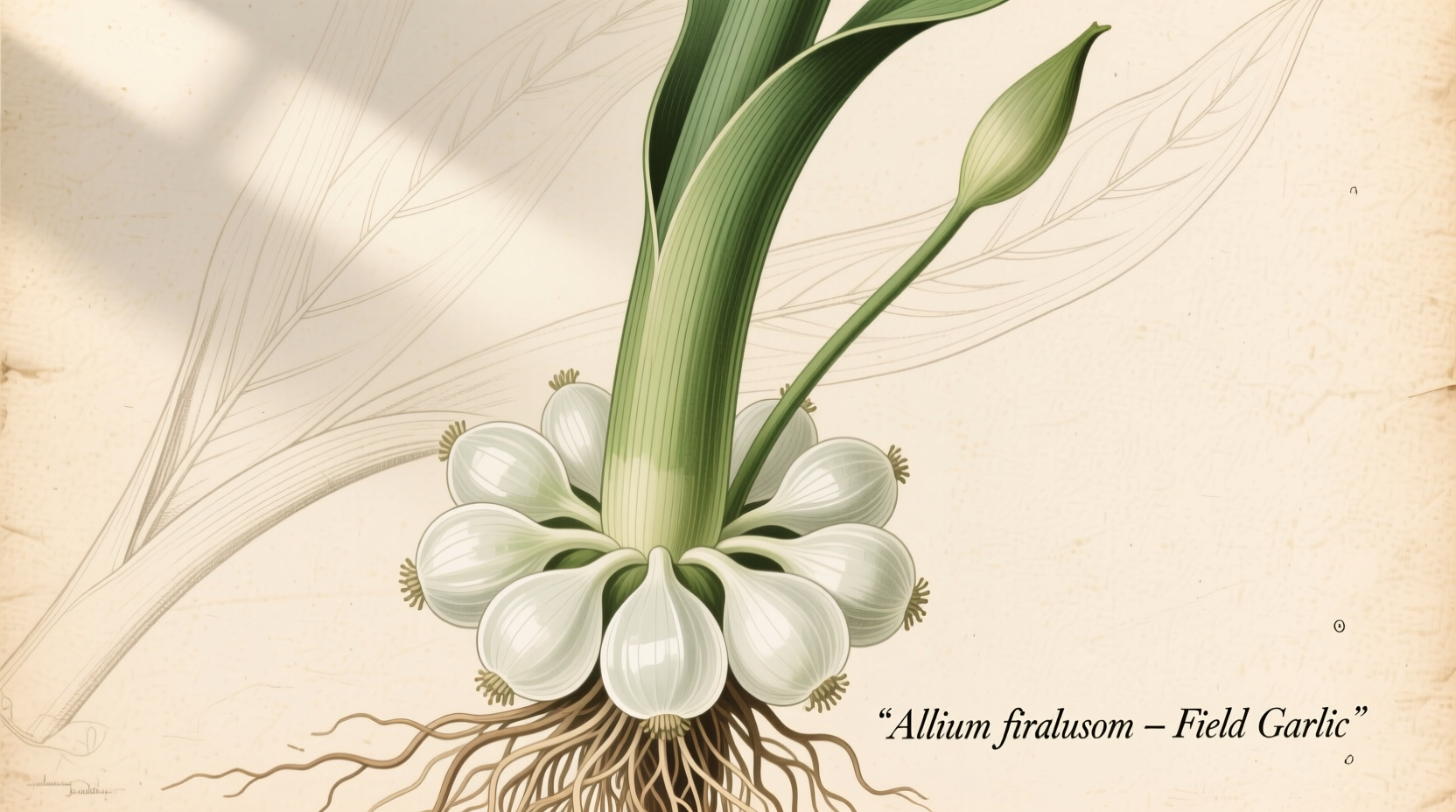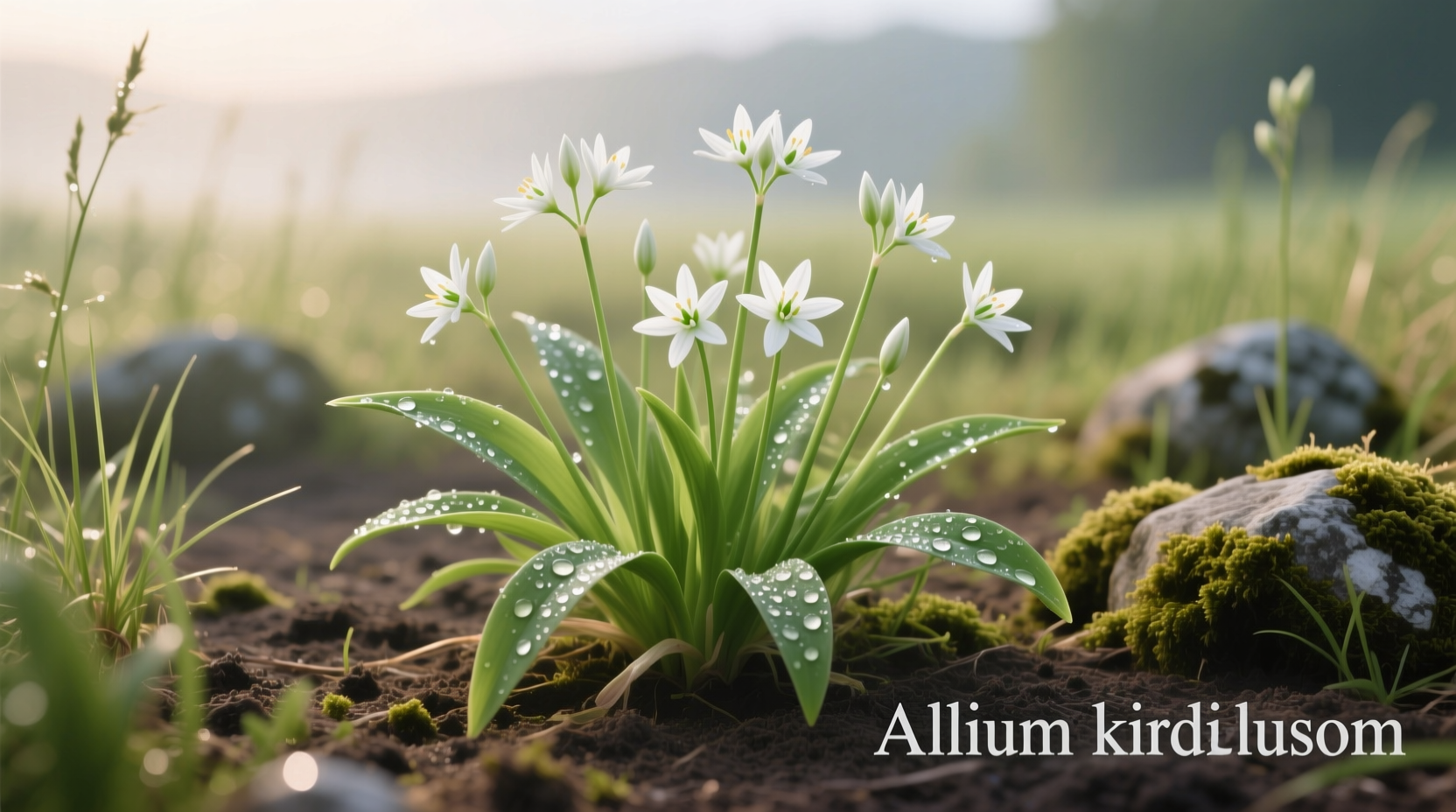For foragers and culinary enthusiasts seeking wild ingredients, field garlic offers a free, flavorful addition to your pantry—but only if you can identify it correctly. This comprehensive guide provides the essential knowledge you need to safely find, harvest, and use this versatile wild edible while avoiding dangerous look-alikes.
How to Identify Field Garlic: The Visual Checklist
Field garlic (Allium vineale) belongs to the Allium family, sharing characteristics with cultivated garlic but with distinct features that help with identification. When searching for this wild edible, focus on these key identifiers:
- Bulb structure: Small, clustered bulbs (typically 0.5-1 inch diameter) with a papery outer layer
- Stem characteristics: Hollow, round stems that grow 1-3 feet tall
- Leaf appearance: Flat, grass-like leaves with a distinct garlic scent when crushed
- Flower features: Purple or pink spherical flower clusters that may contain small bulbils
- Seasonal timing: Most identifiable in spring when flowering, but edible year-round
The most reliable identification method is the smell test—genuine Allium species emit a distinctive garlic or onion odor when any part of the plant is crushed. This simple verification step separates edible Alliums from dangerous look-alikes.
| Plant Type | Key Identification Features | Safety Status | Distinctive Characteristics |
|---|---|---|---|
| Field Garlic (Allium vineale) | Hollow stems, clustered bulbs, garlic scent | Edible | Strong garlic odor, purple flower clusters |
| Death Camas (Toxic) | Solid stems, no garlic scent, white flowers | Poisonous | No odor or unpleasant smell, grows in similar habitats |
| Wild Garlic (Ramsons) | Broad leaves, single bulb, milder scent | Edible | Grows in woodland areas, not fields |
| Crow Garlic (Allium vineale variant) | Similar to field garlic but with larger bulbs | Edible | Often found in similar habitats as field garlic |
Critical Safety Guidelines for Foraging Field Garlic
Field garlic's resemblance to toxic plants makes proper identification non-negotiable. According to the USDA Natural Resources Conservation Service, misidentification of wild Allium species accounts for numerous poisoning incidents each year. Follow these safety protocols:
- Always perform the smell test—genuine field garlic emits an unmistakable garlic aroma
- Examine the stem cross-section—field garlic has hollow stems while toxic look-alikes have solid stems
- Check the bulb structure—field garlic forms clustered bulbs, not a single large bulb
- Avoid plants near roadsides—potential contamination from vehicle emissions
- When in doubt, leave it out—never consume a plant you cannot positively identify
For authoritative identification resources, consult the USDA Plants Database profile for Allium vineale, which provides verified botanical characteristics and distribution maps.

Harvesting Field Garlic: Timing and Technique
Field garlic can be harvested throughout the growing season, but timing affects flavor intensity and plant availability:
- Spring (March-May): Best time for harvesting greens and developing bulbs; milder flavor
- Summer (June-August): Bulbs fully developed with stronger flavor; watch for flowering
- Fall (September-November): Second growth period after summer dormancy; good for bulb harvesting
- Winter: Limited availability in mild climates; focus on protected areas
When harvesting, use a small trowel to carefully dig around the plant to extract the entire bulb cluster without damage. Leave some plants to ensure continued growth in the area—sustainable harvesting practices maintain healthy populations for future seasons.
Culinary Applications: Transforming Field Garlic into Delicious Dishes
Field garlic's intense flavor works well in recipes where a robust garlic presence is desired. Unlike cultivated garlic, it offers both edible bulbs and greens, providing versatility in the kitchen:
- Raw applications: Finely chop greens for salads, compound butters, or as a garnish
- Cooked preparations: Sauté bulbs and greens as you would cultivated garlic in stir-fries and pasta dishes
- Preserving methods: Create garlic-infused oils, pesto, or pickle the bulbs for extended use
- Substitution ratios: Use 1:1 for cultivated garlic but reduce quantity if sensitive to strong flavors
Professional chefs often blend field garlic with milder alliums to balance its intense flavor profile. According to university extension research, the wild variety contains higher concentrations of allicin—the compound responsible for garlic's health benefits—making it potentially more potent medicinally than cultivated varieties.
Preservation Techniques for Year-Round Enjoyment
To extend the enjoyment of your field garlic harvest beyond the growing season, consider these preservation methods:
- Drying: Hang small bunches in a cool, dry place until completely dry; store in airtight containers
- Freezing: Chop and freeze in ice cube trays with olive oil for ready-to-use cooking portions
- Pickling: Preserve bulbs in vinegar brine for a tangy condiment that lasts months
- Pesto: Blend greens with nuts, cheese, and oil for a flavorful frozen preserve
Properly preserved field garlic maintains much of its distinctive flavor and nutritional value for 6-12 months, allowing you to enjoy this wild edible throughout the year.
Ecological Context: Understanding Field Garlic's Role in the Ecosystem
While often considered a weed in agricultural settings, field garlic plays important ecological roles. According to research from Cornell University's Department of Horticulture, this plant contributes to soil health through its deep root system and provides early-season nectar for pollinators. Its presence often indicates disturbed soil that's in the process of ecological succession.
Field garlic spreads primarily through bulbils and underground bulbs rather than seeds, which explains its tendency to form dense colonies in suitable habitats. Understanding this growth pattern helps foragers locate productive patches year after year while respecting the plant's ecological niche.











 浙公网安备
33010002000092号
浙公网安备
33010002000092号 浙B2-20120091-4
浙B2-20120091-4